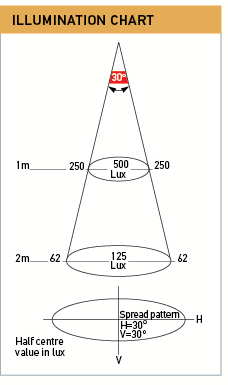 Illumination Charts Explained
Illumination Charts Explained
HELLA light performance charts show luminance and spread in an easy to read format. At the top is the spread, with the boundary threshold being defined as half the peak luminance. While there is light beyond the indicated angles, the majority of light will be inside the cone shown.
The difference between lux (illuminance) and lumen (luminous flux) is that lux takes into account the area over which the luminous flux is spread. Accordingly the lux figure decreases with distance. Most interior lamps will be installed at around the 2 - 2.5 metre height.
As a guideline, some 40 - 100 lux is required for corridors and passageways, around 300 lux for reading and 500 - 800 lux for offices.
The spread pattern may not be designed symmetrical so the spread horizontally (H) and vertically (V) are given.
Luminance is additive, meaning overlapping light patterns or multiple lamps lighting the same surface add their luminance.
One Lux represents the intensity of the light of a full moon (under clear atmospheric conditions) or just sufficient light by which to read a newspaper.
You may also be interested in information about Isolux charts and Isolux lighting diagrams.
